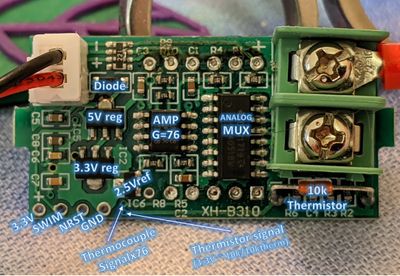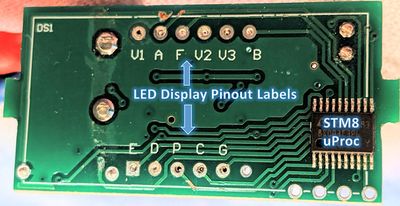Difference between revisions of "ThermoPiggy"
(New Page) |
|||
| Line 8: | Line 8: | ||
==XH-B310 Overview== | ==XH-B310 Overview== | ||
| + | [[File:XH-B310_Front.jpg|400px|thumb|right|Back of the unit]][[File:XH-B310_Back.JPG|400px|thumb|right|Front of the unit, LED display removed]] | ||
The XH-B310 is a clever design and can be broken down into the following components: | The XH-B310 is a clever design and can be broken down into the following components: | ||
Revision as of 12:04, 9 July 2020
Problem Statement
The XH-B310 is an inexpensive and wonderful temperature display. It can be powered from 12V or a 9V battery, and displays the K-type thermocouple temperature on a large LED display. The best part is that they can ready up to 800 degrees C! These are super useful for keeping an eye on a reflow oven temperature, or a distillation or liquid temperature during chemistry experiments and so on. The possibilities are really endless. It is also, oddly, cheaper than a thermocouple IC breakout board several times over.
Unfortunately the developers did not think to provide the temperature data to the user in any sort of easily digestible form. Using these to feed data into a smarter system is unfortunately not so easy. This is truly disheartening as the system uses an STM8 micro-controller, which could easily provide temperature data at 9600 baud on a spare pin.
System Overview
It should be possible to piggy-back an arduino nano onto the analog signals output by the various sensors to the board's ADC. This is not as ideal as just getting the result from the micro for many reasons, but it does mean it is entirely possible, and indeed quite likely, that each board will display a slightly different reading. This will have to be acceptable...
XH-B310 Overview
The XH-B310 is a clever design and can be broken down into the following components:
- 5V Regulator - To provide a constant voltage to the LEDs
- 3.3V Regulator - Powers the rest of the board
- op-amp - 76x gain stage for thermocouple voltage
- analog mux - to act as a high impedance buffer for the thermocouple? Maybe there are other designs with more than one thermcouple? Still seems strange to devote so much board space to a part that isn't even really used.
- 2.5V precision reference for the ADC
- 10k thermistor to sense ambient temperature
- a diode for reverse polarity protection
- An stm8s003f3 microcontroller

